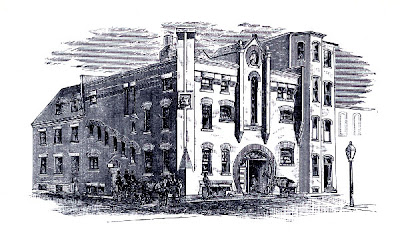By Donald F. Smith, Cornell University
This historical blog is in recognition of the 150th anniversary
of the American Veterinary Medical Association (1863-2013)
The New York Times called Harvard Veterinary School the “leading school of the science in the country and the one to which the present development of veterinary medicine in the United States is largely due”. The date was Dec. 2, 1900 and the Times was mourning the anticipated closure due to lack of funding.
Harvard’s veterinary school
and clinics closed the following year. Established in 1882 as a department
within the medical school, Harvard maintained the Village Street Hospital for
the treatment and observation of sick animals. The hospital had an entrance door large enough to accommodate a circus elephant. According to the Times, more small and large animal patients were admitted to Harvard at that time than to any
other veterinary college in the United States.
Despite being self-supported with neither endowment income nor appropriation from the Commonwealth of Massachusetts, the school also maintained a free clinic on Piedmont Street for charity, and to improve the teaching resources of the school.
Despite being self-supported with neither endowment income nor appropriation from the Commonwealth of Massachusetts, the school also maintained a free clinic on Piedmont Street for charity, and to improve the teaching resources of the school.
 |
| Harvard School of Veterinary Medicine, circa 1883 Image from Countway Library of Medicine (Alliance of the Boston Medical Library and Harvard Medical School) |
There were only 128 veterinary graduates during the 20-year history of the school, but two are known to have made major contributions to medicine and science. One was Richard P. Lyman, Jr, (MDV 1894). The son of the School’s dean, the younger Lyman was in clinical practice for 17 years and also taught at the Kansas City Veterinary School before becoming the founding dean of Michigan State’s College of Veterinary Medicine in 1910.
The other was Langdon Frothingham (MDV 1889). His initial job was at the
University of Nebraska where he was director of the pathobiology
laboratory. He was also the university’s first football coach, and the only
undefeated (2-0) and unscored-upon coach in the history of Nebraska football.
 |
| Langdon Frothingham, Harvard veterinary graduate (MDV, 1889) |
Frothingham’s more memorable
achievement occurred in Dresden, Germany (1892-94)
where he worked with Heinrich Johne and co-discovered the infectious disease that
caused chronic diarrhea and weight loss in cattle and was originally thought to
be intestinal tuberculosis. A new organism was discovered by the two
scientists and the disease was called “pseudotuberculous enteritis”. It is know today as Johne’s
Disease.
Returning to the United States in
1895, Frothingham worked briefly at Yale, then as instructor in pathology at his alma mater (Harvard Veterinary). His brilliant research in veterinary pathology, including important articles on
rabies, spanned three decades until he retired in 1928 from Harvard’s medical school, where he was employed after the veterinary school closed. The late E.L. Stubbs, veterinary pathologist and
historian, wrote that Frothingham “reigned alone during the 19th
century as a veterinary pathologist in the United States” and was a “leading authority on animal pathology in Boston medical circles".
One can only speculate how much greater
our veterinary profession would be today if Harvard’s veterinary school was still in existence, and integrated within the Boston medical
community as it was over a century ago.
Dr. Smith thanks Professor Howard K. Erickson, Kansas State University College of Veterinary Medicine, for his support, especially with reference to the contributions of Langdon Frothingham.
Selected References:
The New York Times, Dec 2, 1900
E.L.Stubbs, Biographical Sketch: Langdon Frothingham (1866-1935). Vet Path 1966 2:565.
Dr. Smith welcomes comments at dfs6@cornell.edu.
Dr. Smith thanks Professor Howard K. Erickson, Kansas State University College of Veterinary Medicine, for his support, especially with reference to the contributions of Langdon Frothingham.
Selected References:
The New York Times, Dec 2, 1900
E.L.Stubbs, Biographical Sketch: Langdon Frothingham (1866-1935). Vet Path 1966 2:565.
Dr. Smith welcomes comments at dfs6@cornell.edu.